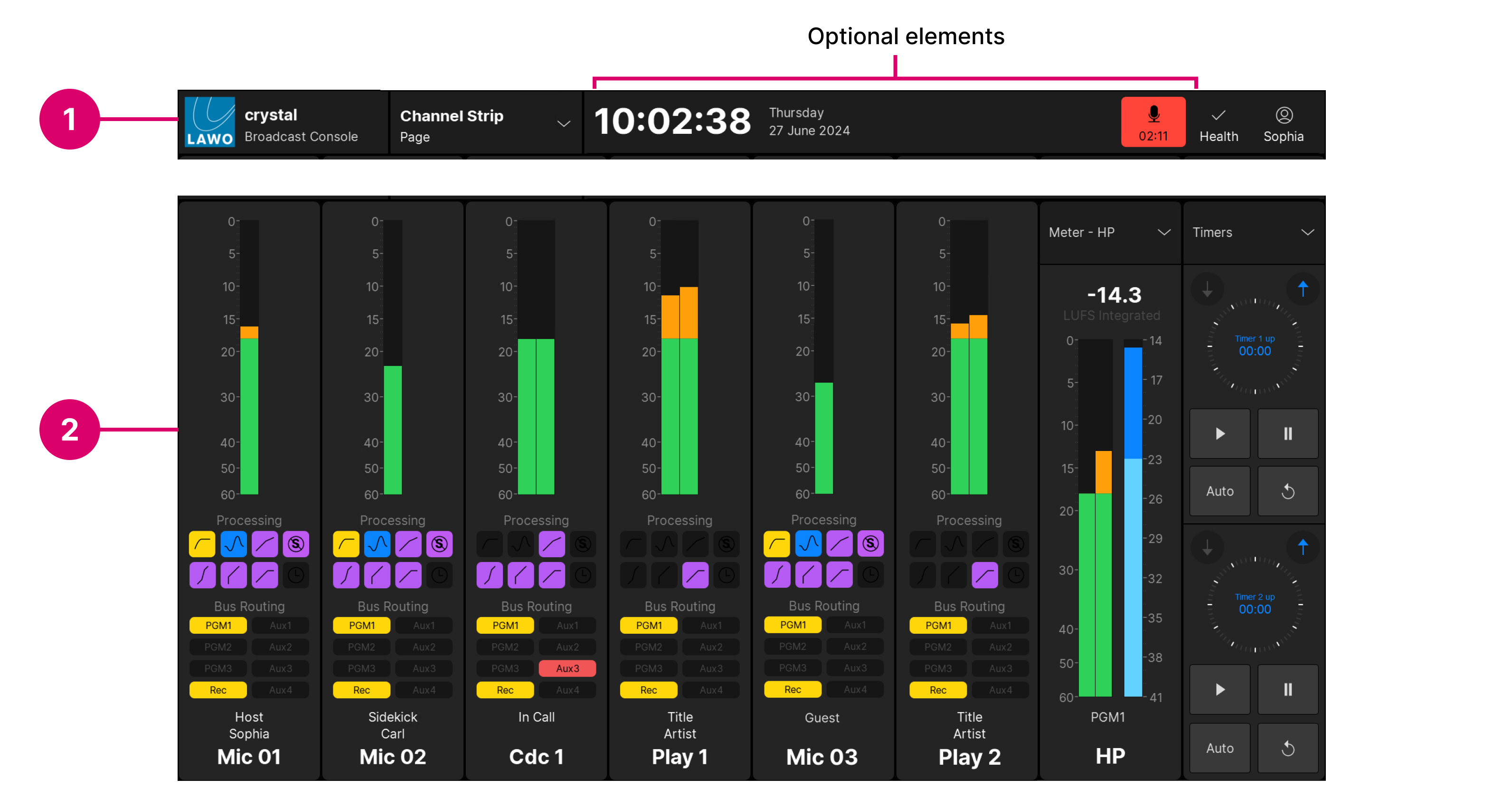crystal VX - Operating Principles
Each VX display is divided into two areas. The top bar (1) is always visible, while the main working area (2) is switched between different pages.

1. Top Bar
The top bar includes some elements that are always displayed and some that are optional. Each of the optional elements can be enabled (or disabled) from the 'Settings → Top Bar' dialog box.
Working from left to right, the elements are:
- LAWO logo and product name (crystal Broadcast Console) - for information only.
- Current page name (e.g. Channel Strip). Touch the Page button to change the page.
- System Clock (optional) - for information only. The system clock shows the time and date running on the host PC. This can be transferred to Power Core using SoP Explorer (as described later).
- Mic Timer (optional) - for information only. The indicator lights in red and counts up from 00:00 whenever a Mic source fader is open. The timer resets to 00:00 once all Mic source faders are closed.
- Health indicator - shows the health of the system. A white tick shows that everything is ok. If there is a problem, then an exclamation mark appears. In each case, touch the indicator to view more information.
- User name (e.g. Sophia). Touch the user name to open the user menu.
- From here you can sign in (or sign out) and close the VX App.
- Once logged in, the following functions become available: edit user labels, load/save/delete snapshot, adjust settings and lock screen.
2. Current Page
The main working area can be switched to one of four pages.
To change the page, touch the Page button (below the current page name) and choose an option from the drop-down menu.

There are four pages as follows.
- Channel Strip - visual feedback for the sources assigned to the fader strips and/or central functions.
- Playout - a specific web page.
- Browser - web browser including bookmarks.
- Routing - control of the system's output routing.
If your console is fitted with more than one VX module, then you can show a different page on each display.
Dialog Boxes (Overlays)
The following dialog boxes appear automatically in response to an operation from either the surface or GUI. In each case, the dialog box appears on top of the current page (as an overlay).
| Dialog Box Name | Function | How to Open | |
|---|---|---|---|
| View and control parameters for the source in access. | Press a fader strip Access key once. | ||
| Assign Source | Assign a source to a fader strip. | Press a fader strip Access key twice in quick succession. | |
| Select Mon Source | Select a monitor source. | Press and hold the Soft Select key (for CR or HP). | |
| Select Mon Mode | Change the monitoring mode. | Press the Mode key (for CR or HP). | |
| User Login | Access protected functions (by logging in). | Select Login from the GUI user menu. | |
| User Labels Editor | Edit the user labels for any source. | Select Edit User Labels from the GUI user menu. | |
| Load/Save/Delete Snapshot | Load, save or delete a GUI snapshot. | Select Load/Save/Delete Snapshot from the GUI user menu. | |
| Settings | Customize the operation for the current user. | Select Settings from the GUI user menu. | |
| Help | Open the user manual on docs.lawo.com. | Select Help from the GUI user menu. | |